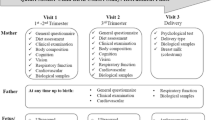Abstract
As a part of a large-scale work aimed at studying the health effects of boron (B) in residents of a country with the world’s largest supply, developmental effects of B are presented. Spontaneous abortions, stillbirths, and congenital malformations in addition to early infant mortality were questioned in the field by home visits. Although the number of families so far ascertained is rather small, the rates related to spontaneous abortions and stillbirths from high B exposure vs low B exposure subpopulations revealed no differences of significance, providing no evidence that B affects human development adversely.
Similar content being viewed by others
References
B. S. Ssayli, E. Tüccar, and A. H. Elhan, An assessment of fertility in boron-exposed Turkish subpopulations,Reprod. Toxicol.12(3), 297–304 (1998).
J. J. Heindel, C. J. Price, and B. A. Schwetz, The developmental toxicity of boric acid in mice, rats, and rabbits,Environ. Health Perspectives 102, Suppl. 7, pp. 107–112 (1994).
J. Schowing and P. Cuevas, Teratogenic effects of boric acid upon the chick. Macroscopic results,Teratology 12, 334–338 (1975).
T. H. Shepard,Catalog of Teratogenic Agents, 5th ed. Johns Hopkins University Press, Baltimore, pp. 75–76 (1986).
NTP, Developmental Toxicity Evaluation of Boric Acid (CAS no. 10043-35-3) Administered to Sprague-Dawley Rats, Final Study Report, National Toxicology Program. NTIS # PB91137588/AS (1990).
NTP, Developmental Toxicity Evaluation of Boric Acid (CAS no. 10043-35-3) Administered to CD-1 Swiss Mice. National National Toxicology Program. Final Study Report NTIS # PB91132332 (1990).
NTP, Developmental Toxicity Evaluation of Boric Acid (CAS no. 10043-35-3) Administered to New Zealand White Rabbits by Gavage on Gestational Days 6 through 19. Final Study Report. NTIS # PB92129550/AS (1991).
M. D. Whorton, J. L. Haas, L. Trent, and O. Wong, Reproductive effects of sodium borates on male employees: birth rate assessment,Occup. Environ. Med. 51, 761–767 (1994).
Author information
Authors and Affiliations
Rights and permissions
About this article
Cite this article
Tüccar, E., Elhan, A.H., Yavuz, Y. et al. Comparison of infertility rates in communities from boron-rich and boron-poor territories. Biol Trace Elem Res 66, 401–407 (1998). https://doi.org/10.1007/BF02783151
Published:
Issue Date:
DOI: https://doi.org/10.1007/BF02783151




